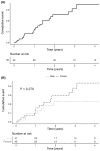Nationwide incidence of and risk factors for undergoing incisional glaucoma surgery following infantile cataract surgery
- PMID: 39009616
- PMCID: PMC11251266
- DOI: 10.1038/s41598-024-66559-z
Nationwide incidence of and risk factors for undergoing incisional glaucoma surgery following infantile cataract surgery
Abstract
Nationwide incidence and risk factors for incisional glaucoma surgery post-infantile cataract (IC) surgery in children remain poorly understood. We conducted a population-based cohort study using the Korean national health claims database to identify IC patients diagnosed before age 1 who had IC surgery among all Korean born between 2008 and 2018 (n = 9,593,003). We estimated the annual occurrence of undergoing incisional glaucoma surgery following IC surgery in the general population aged 0-10. The risk factors for incisional surgery including systemic comorbidities and ophthalmic anomalies were analyzed by multivariable logistic regression. Of 650 patients who had undergone IC surgery with a mean (standard deviation [SD]) follow-up period of 6.2 (3.2) years, 92 (14.2%) were diagnosed with glaucoma following infantile cataract surgery (GFICS). Among them, 21 patients (22.8%) underwent incisional glaucoma surgery after a mean (SD) follow-up duration of 5.4 (2.8) years from the diagnosis of GFICS. Median (InterQuartile Range) age at incisional surgery was 4 (2,6) years old. Twenty of 21 patients (95.2%) underwent incisional glaucoma surgery within 3 years of diagnosis of GFICS. No factors, except younger age at glaucoma diagnosis (P = 0.03), were associated with undergoing incisional surgery. These findings can better understand the epidemiologic features and clinical courses of GFICS.
Keywords: Congenital; Glaucoma; Incidence; Infantile cataract; Risk; Surgery.
© 2024. The Author(s).
Conflict of interest statement
The authors declare no competing interests.
Figures


Similar articles
-
Nationwide Incidence of Infantile Cataract Surgery and Risk of Secondary Glaucoma in a Population-based Birth Cohort.Am J Ophthalmol. 2023 Feb;246:130-140. doi: 10.1016/j.ajo.2022.10.015. Epub 2022 Nov 1. Am J Ophthalmol. 2023. PMID: 36328202
-
Incidence of and factors associated with glaucoma after surgery for congenital cataract: findings from the British Congenital Cataract Study.Ophthalmology. 2008 Jun;115(6):1013-1018.e2. doi: 10.1016/j.ophtha.2007.09.002. Epub 2007 Dec 27. Ophthalmology. 2008. PMID: 18164065
-
Incidence and risk factors of glaucoma after surgery for congenital cataract diagnosed under one year of age: Protocol for Korean Nationwide Epidemiological Study for Childhood Glaucoma (KoNEC).PLoS One. 2022 Feb 17;17(2):e0264020. doi: 10.1371/journal.pone.0264020. eCollection 2022. PLoS One. 2022. PMID: 35176075 Free PMC article.
-
The role of primary intraocular lens implantation in the risk of secondary glaucoma following congenital cataract surgery: A systematic review and meta-analysis.PLoS One. 2019 Apr 1;14(4):e0214684. doi: 10.1371/journal.pone.0214684. eCollection 2019. PLoS One. 2019. PMID: 30933995 Free PMC article.
-
Incidence of and Risk Factors for Postoperative Glaucoma and Its Treatment in Paediatric Cataract Surgery.Dev Ophthalmol. 2016;57:40-8. doi: 10.1159/000442500. Epub 2016 Apr 1. Dev Ophthalmol. 2016. PMID: 27043391 Review.
Cited by
-
Comparison of the Intraocular Pressure-lowering Effects of Three Primary Surgical Procedures in Pediatric Aphakic Glaucoma.J Curr Glaucoma Pract. 2025 Jan-Mar;19(1):50-54. doi: 10.5005/jp-journals-10078-1456. Epub 2025 Mar 24. J Curr Glaucoma Pract. 2025. PMID: 40417144 Free PMC article.
References
MeSH terms
Grants and funding
LinkOut - more resources
Full Text Sources
Medical

